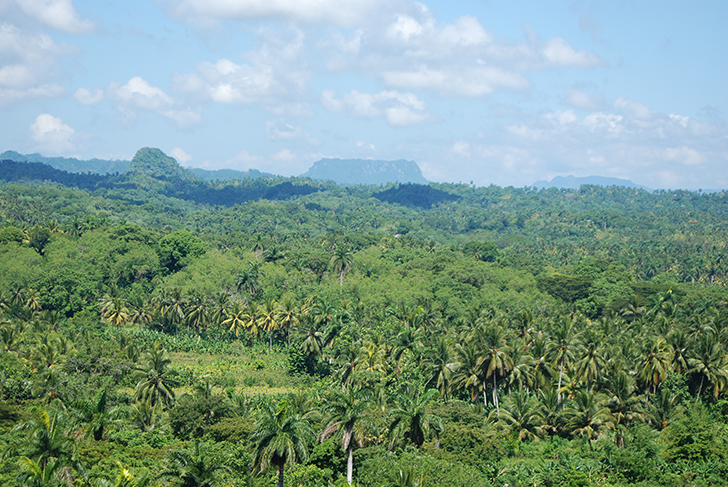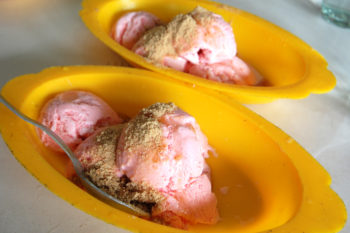One hundred years of solitude? How about 453. A look at a unique, isolated town in Guantánamo Province, Cuba.
BARACOA, CUBA — While sunning on the beach, I sit up to watch a pig chase a dog across the white sand.
Before coming to Baracoa, my jaw would have dropped at the sight. Now I just shrug my burnt shoulders and snort. If you want five-star hotels and sanitized beaches, Baracoa is not the place for you. As beautiful as this secluded playa is, things here are more. . . feral. Cuba is a country that marches to its own off-beat rhythm. The quirks are subtle at first, but with each passing day I hear them louder and louder — and Baracoa, a town on the northeastern tip of the island, is as wildly weird and weirdly wonderful as it gets.

It thunders without rain and pours without warning under clear sunny skies. El Yunque (“the anvil”), the table mountain that dominates the horizon, looks like something out of literary fantasy. Indeed, the town’s isolation and dreamlike existence has been likened to Gabriel García Márquez’s One Hundred Years of Solitude — except we’re talking 453 years.
A fortress of mountains insulates Baracoa from the rest of the island. Before a paved road was finally built in 1964, access to the town was only by sea. Imagine that. If I was here in the ’50s and wanted to kick back daiquiris with my pal Ernie Hemingway in Havana, I’d have to hop on a boat. And what a long way to go. Baracoa is actually closer to Haiti and Jamaica than the capital city.

“Amore!” Marco the visitor from Rome calls out to the pig, unleashing the language of love to entice it to come over. Done with terrorizing the dog, the pig moseys past us, indifferent.
Marco then tries Spanish and waves a made-in-China soda cracker, the only decent snack we could find at the barren shops in town.

My first few days in Cuba were as awkward as a dance on a first date with someone with halitosis. I was befuddled by how things worked (or didn’t work). I was saved by Marco. I met him and three other Italian travellers in the plaza Saturday night. He was the epitome of cool with his tattoo sleeves, panama hat and blue eyes bold and bright like a jungle cat’s. By watching Marco interact with people, I finally understood what it would take to negotiate this country: joke more, smile a lot, express big – throw in a few handshakes and kisses. Funny how watching an Italian was my guide to understanding how to Cha-cha-cha with Cubans.

While Marco glibly moves between Spanish, Italian and English, I’m making ape noises and swinging from the trees. One semester of Spanish failed to teach me key phrases such as “I have diarrhea because the food here is so bad. Do you have Imodium?”
Thankfully, I haven’t needed that phrase in Baracoa. It has discovered something the rest of the rice n’ beans nation hasn’t: flavour. The cuisine is refreshingly different, with ingredients not used elsewhere on the island. Picante crab soup, fish in coconut sauce, buttery garlic shrimp, and for dessert, a sinful, spiced cuppa hot chocolate made with famed Baracoa cacao.

After the gritty urban intensity of Havana and the gaggles of tourists in Trinidad, the workaday world of Baracoa is a joy to watch. Early morning, mothers push their kids out the door (off to school!) — little ones in uniforms of crisp white shirts and red shorts, teens in sky and navy blue. Elderly men as round as meatballs sit at tables, shirtless, already deep into their game of dominoes. Bicycle rickshaws whizz past. The bread man sings his arrival. And the queues have formed. Bloated lines outside of the banks, stores, ration shop, phone centre and bus station.
Obviously, you don’t come here to marvel at the lineups. Baracoa’s draw is its eternal natural beauty.

We all chipped in to hire Martin and his rebuilt ’56 Willys Jeep — essentially a tin can on wheels. Rattling down dirt roads, we leave clouds of dust and panicked chickens in our wake. The countryside is ravishingly lush with forests of banana, cacao and palm trees. We cross rivers where women slap laundry upon the rocks, children frolic in the rapids and men have musical jam sessions on the banks.
We climbed El Yunque, which is the tourist thing to do in Baracoa, a two-and-a-half hour hike through steamy, muddy jungle in punishing midday heat. I’m supposed to write about how magical or inspiring it was. Well, it was magically hellish and it inspired me to quit halfway up; some things are better admired from a distance. I lounged in a hut, drinking green coconut water while the others continued on. They returned hours later, haggard and drenched in sweat; Marco was hobbling. When I asked how it was, he muttered in Italian. Or was it Spanish? Never mind. Sometimes translation is not required.

Just the Facts
DOING Day trips such as the hike up El Yunque ($16) can be arranged the day before at these agencies: Havanatur (Martí #202, 21/64-53-58); Cubatur (Maceo, 21/64-53-06). 40 km northwest of Baracoa, Parque Nacional Alejandro de Humboldt is noted by UNESCO as “one of the most biologically diverse tropical island sites on earth.” Various hikes take you through pristine rainforest to waterfalls and caves. Excursion $24. Playa Maguana is the popular white sand beach but lesser known Playa Cajuajo is cleaner and quieter. Expect to see pigs at both.
DRINKING Every Saturday night, a lively street party takes over the main plaza (Antonio Maceo street). Live music, dancing and lots of rum. Mojitos $2.50, beer $1.50.
AVOIDING The sixth mojito is always a bad idea.
This story was originally published in The Toronto Star on 13 March 2012.

